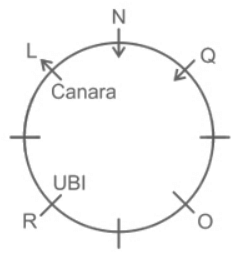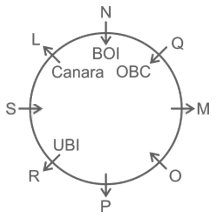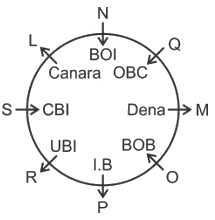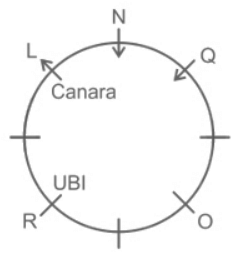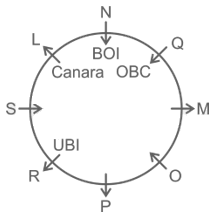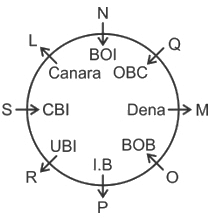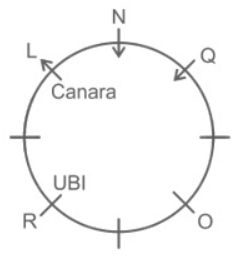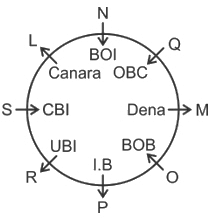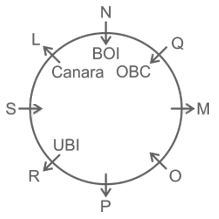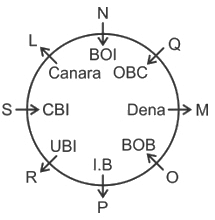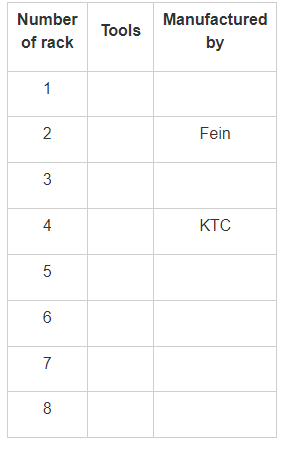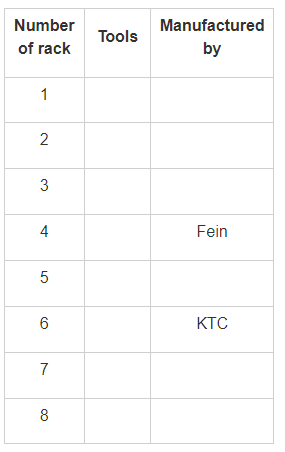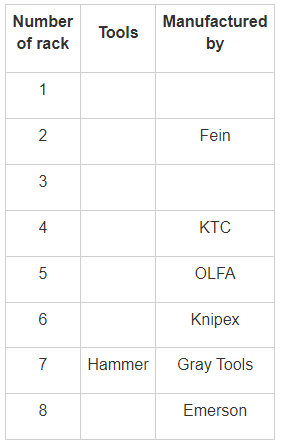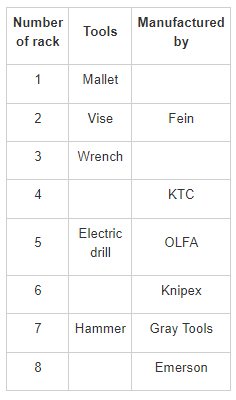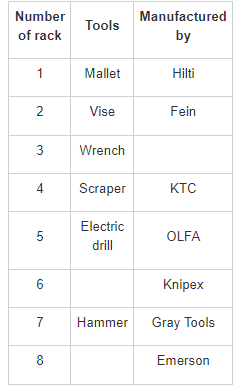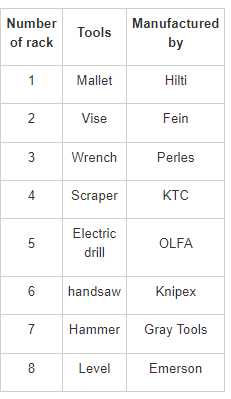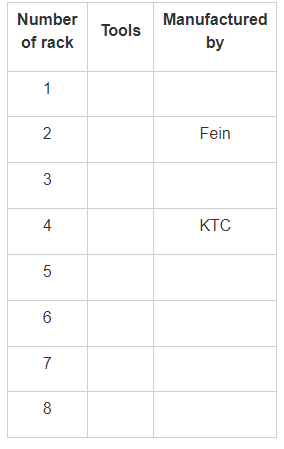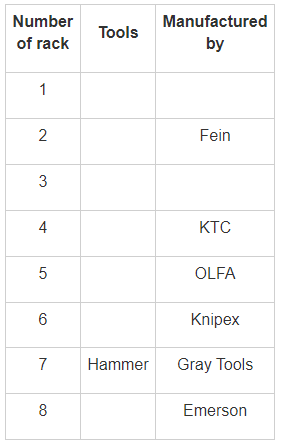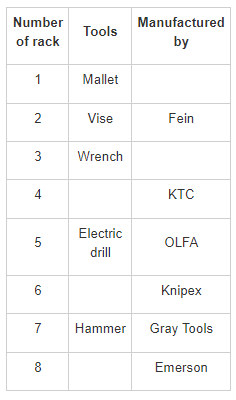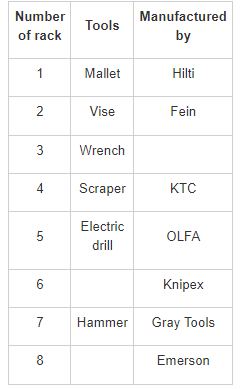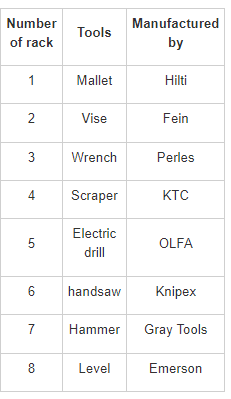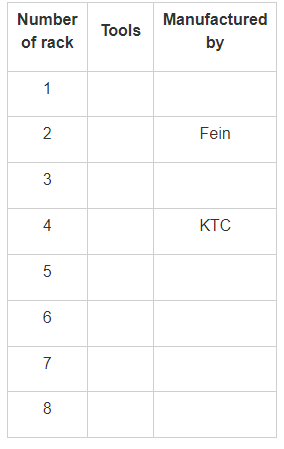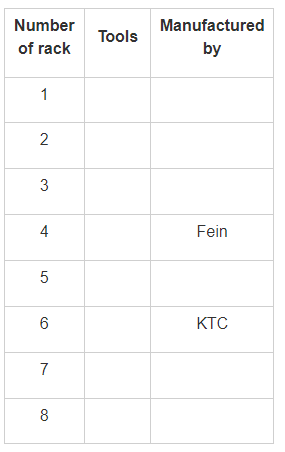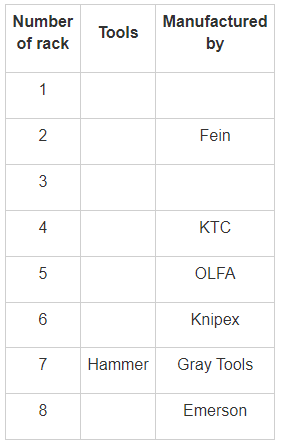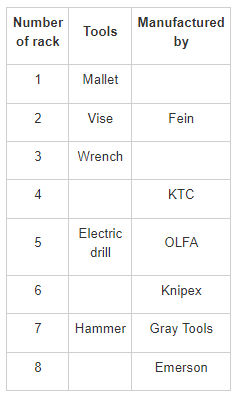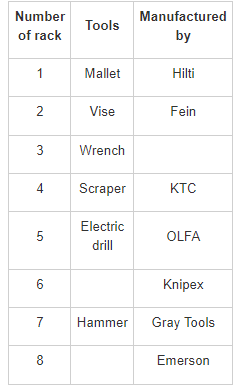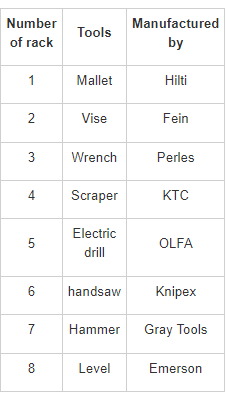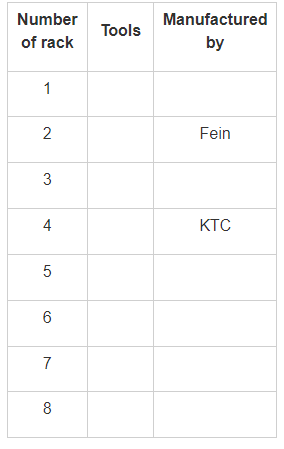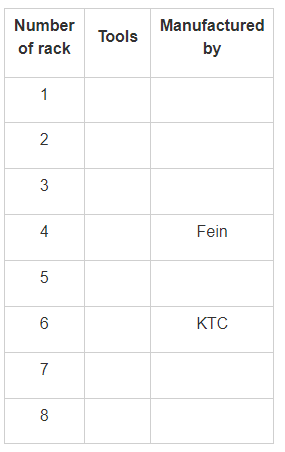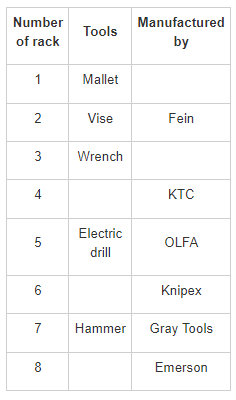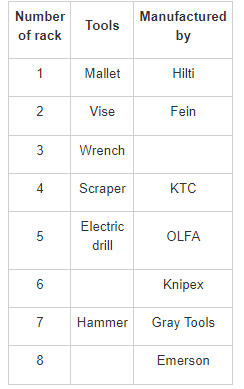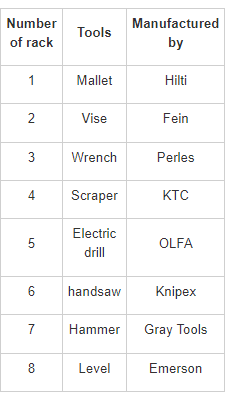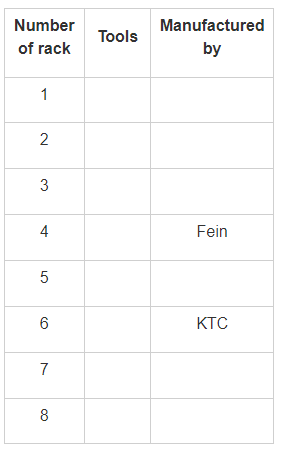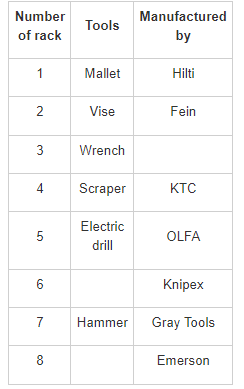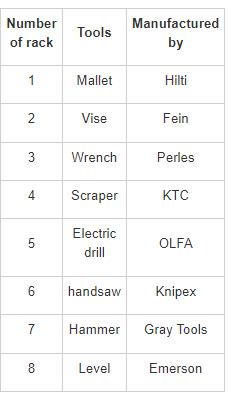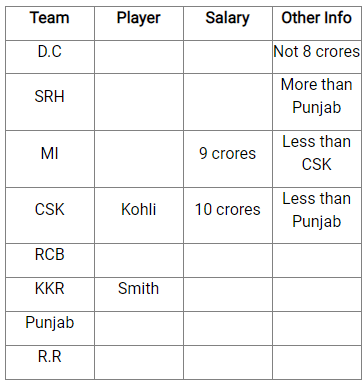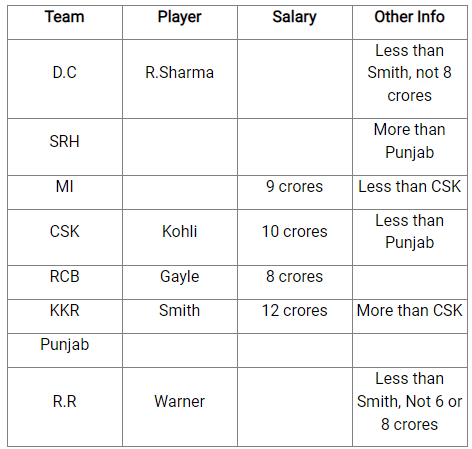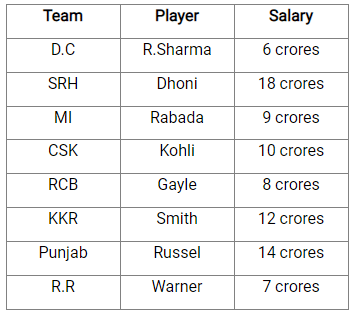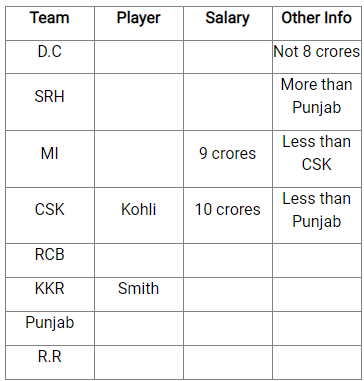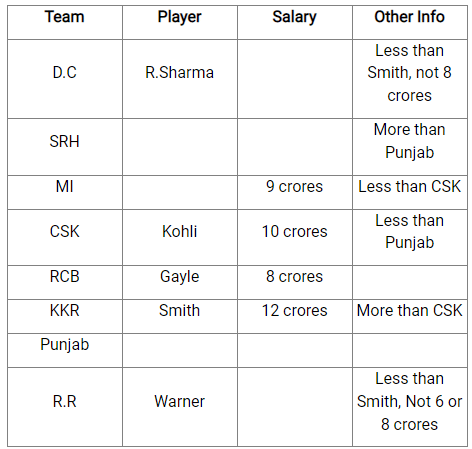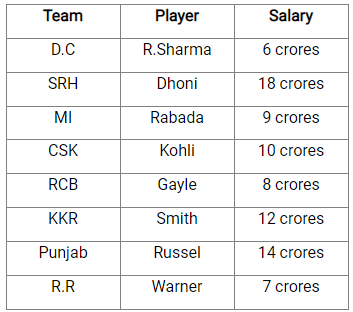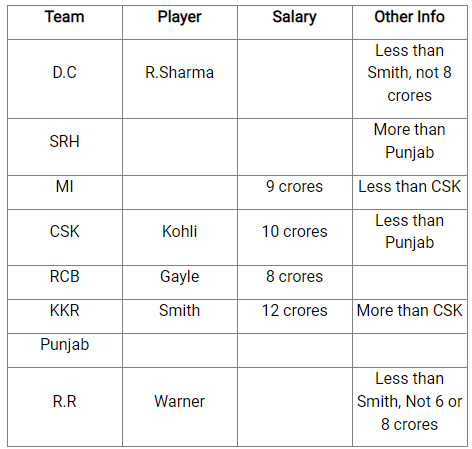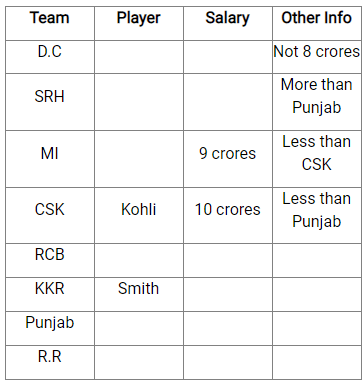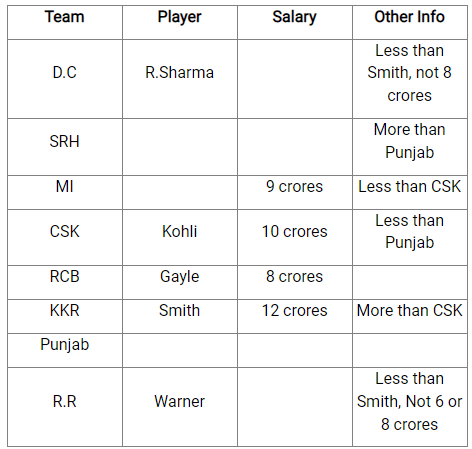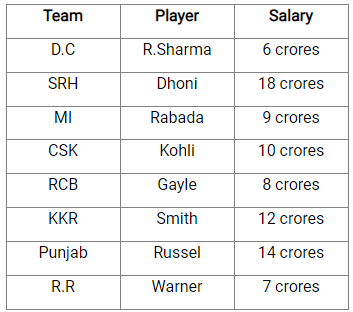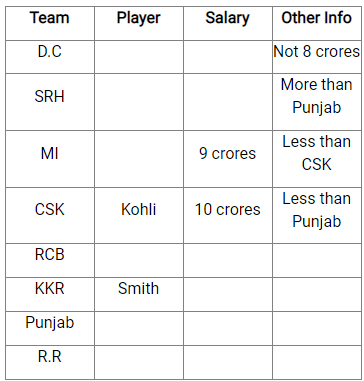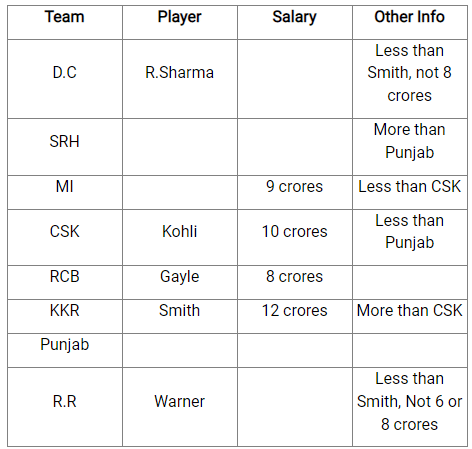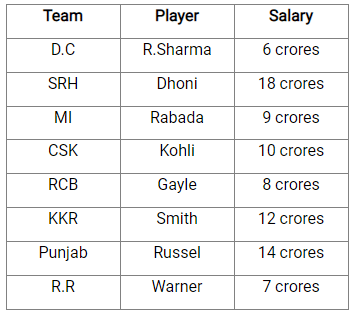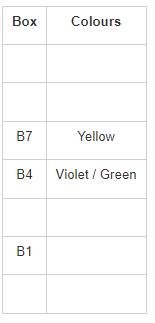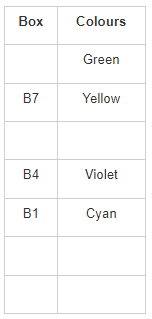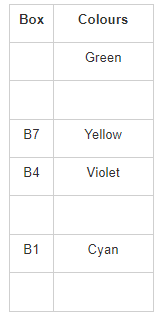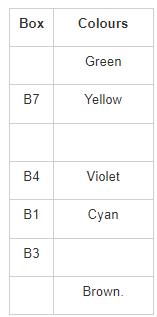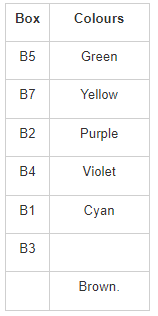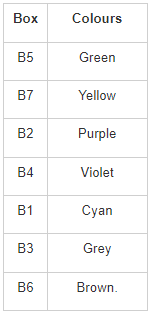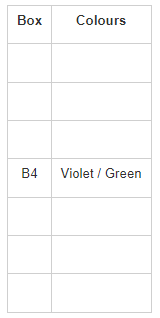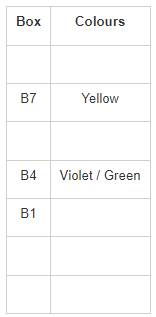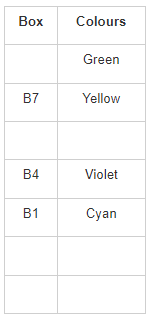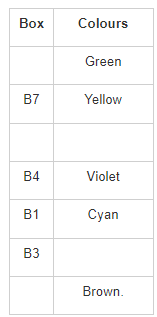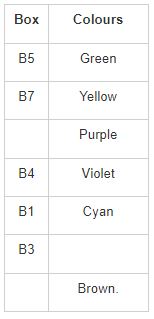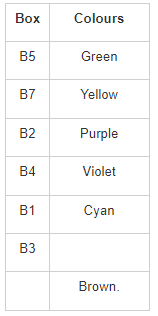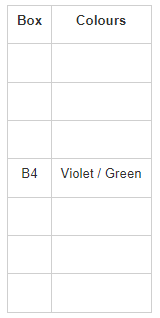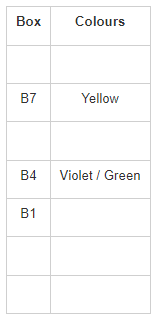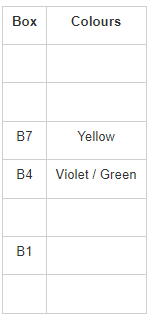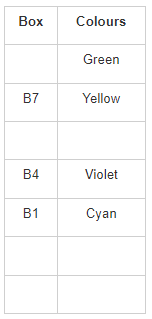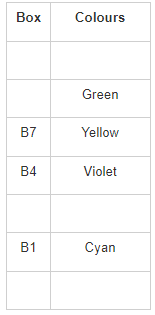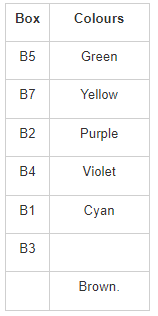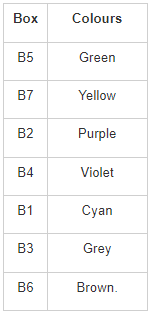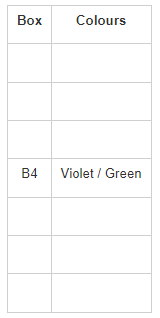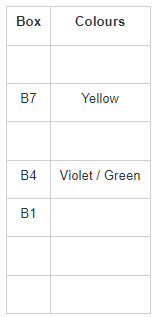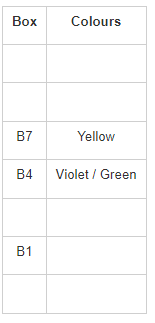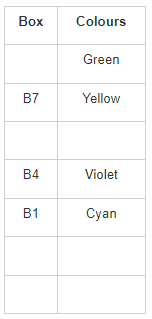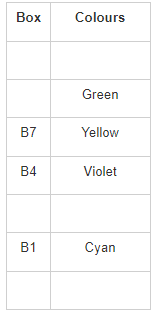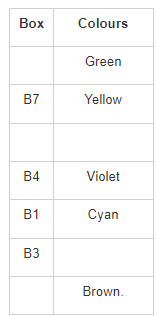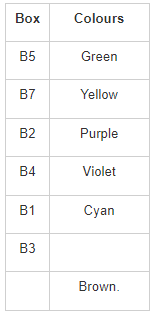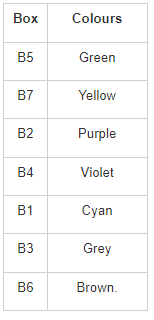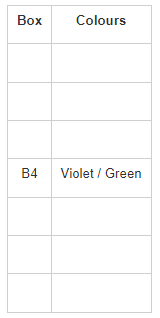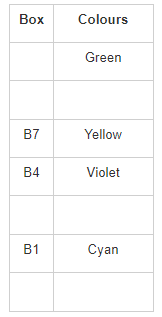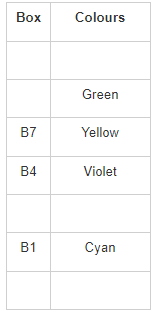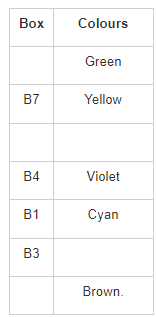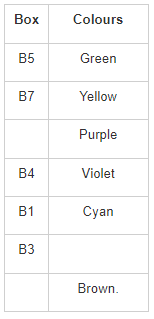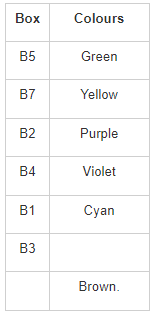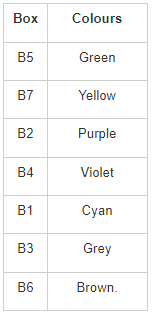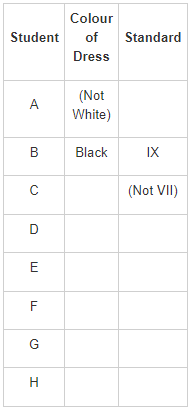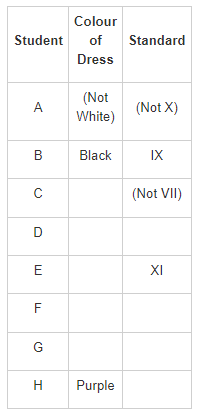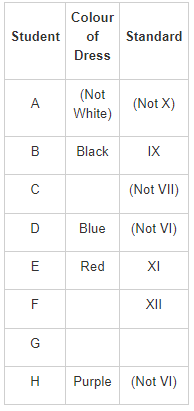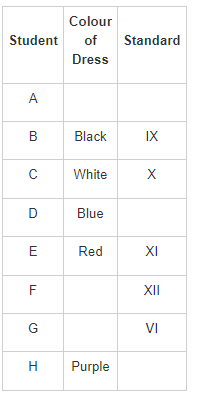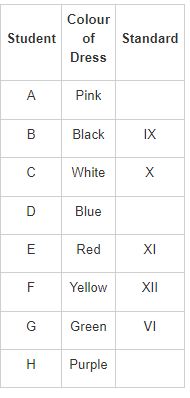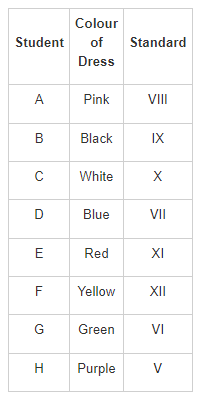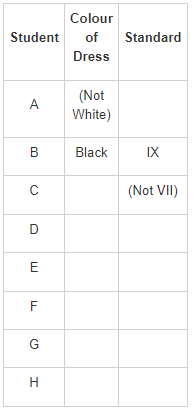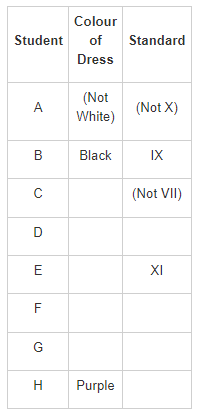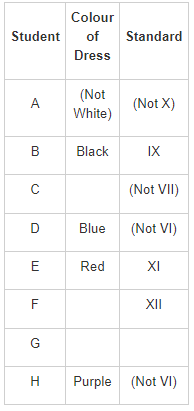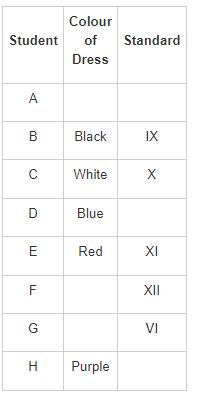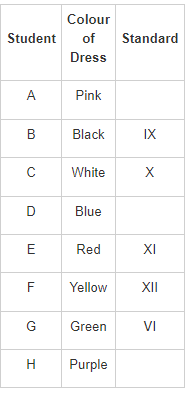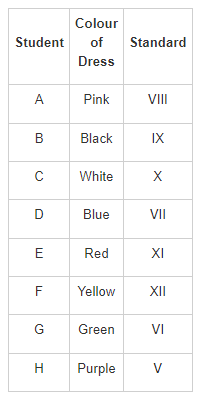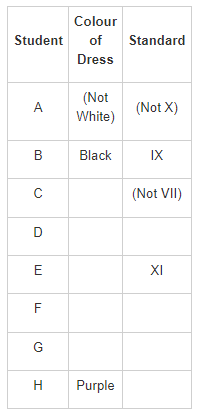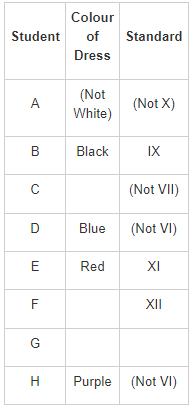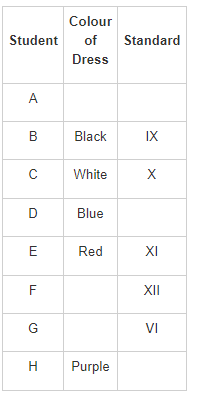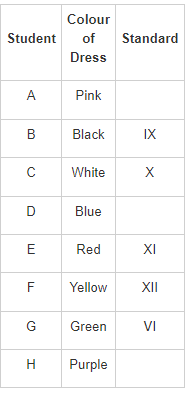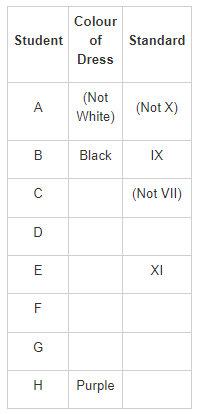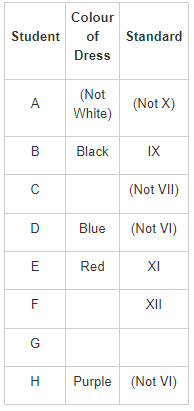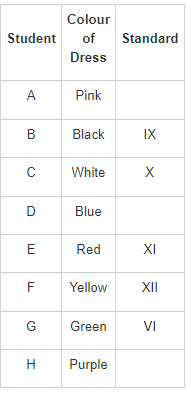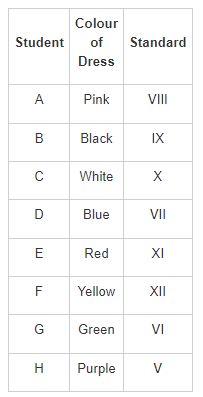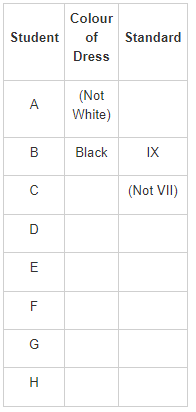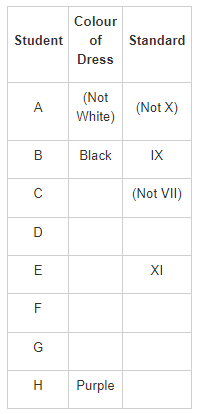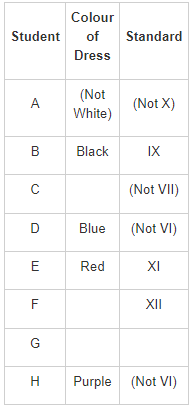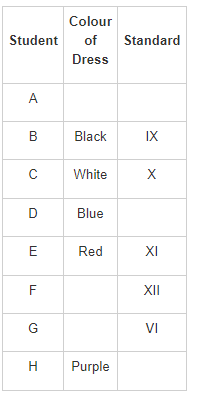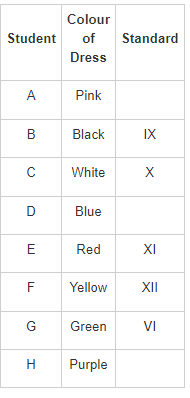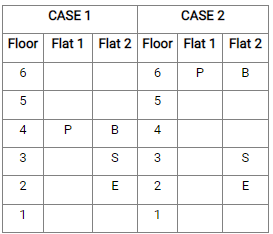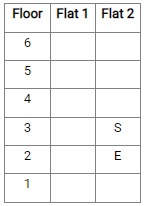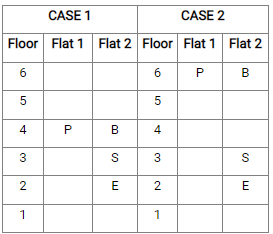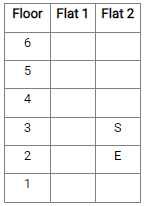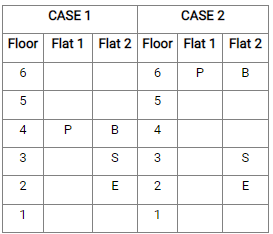IBPS Clerk Mains Mock Test - 7 - Bank Exams MCQ
30 Questions MCQ Test - IBPS Clerk Mains Mock Test - 7
Directions: Study the following information carefully and answer the questions based on it.
Eight people L, M, N, O, P, Q, R and S are sitting around a circular table. Each of them works in different banks viz., Canara, Bank of India (BOI), Central Bank of India (CBI), Bank of Baroda (BOB), Indian Bank (IB), Union Bank of India (UBI), Oriental Bank of Commerce (OBC) and Dena Bank (DB), not necessarily in the same order. Four of them are facing towards the center while others face outside the center.
O is third to the right of S. The one who is working in Indian Bank is to the immediate left of O, who is not working in Dena Bank. R is fourth to the left of Q. Neither R nor Q is an immediate neighbor of O. L is working in Canara Bank and sits third to the right of the one who is working in Indian Bank. The one who is working in Union Bank of India sits second to the left of the one who is working in Canara Bank. The one who is working in Oriental Bank of Commerce sits second to the right of O. The one who works in Bank of India sits exactly between L and Q and adjacent to them. The one who works in the Central Bank of India sits second to the right of the one who works in the Bank of India. P sits third to the left of L. N is facing the center and is to the immediate right of both L and Q. M and R faces the same direction. L is facing the opposite direction of N.
Who is sitting opposite to Q?
Directions: Study the following information carefully and answer the questions based on it.
Eight people L, M, N, O, P, Q, R and S are sitting around a circular table. Each of them works in different banks viz., Canara, Bank of India (BOI), Central Bank of India (CBI), Bank of Baroda (BOB), Indian Bank (IB), Union Bank of India (UBI), Oriental Bank of Commerce (OBC) and Dena Bank (DB), not necessarily in the same order. Four of them are facing towards the center while others face outside the center.
O is third to the right of S. The one who is working in Indian Bank is to the immediate left of O, who is not working in Dena Bank. R is fourth to the left of Q. Neither R nor Q is an immediate neighbor of O. L is working in Canara Bank and sits third to the right of the one who is working in Indian Bank. The one who is working in Union Bank of India sits second to the left of the one who is working in Canara Bank. The one who is working in Oriental Bank of Commerce sits second to the right of O. The one who works in Bank of India sits exactly between L and Q and adjacent to them. The one who works in the Central Bank of India sits second to the right of the one who works in the Bank of India. P sits third to the left of L. N is facing the center and is to the immediate right of both L and Q. M and R faces the same direction. L is facing the opposite direction of N.
Who is sitting to the immediate left of the one who works in the Indian Bank?
Directions: Study the following information carefully and answer the questions based on it.
Eight people L, M, N, O, P, Q, R and S are sitting around a circular table. Each of them works in different banks viz., Canara, Bank of India (BOI), Central Bank of India (CBI), Bank of Baroda (BOB), Indian Bank (IB), Union Bank of India (UBI), Oriental Bank of Commerce (OBC) and Dena Bank (DB), not necessarily in the same order. Four of them are facing towards the center while others face outside the center.
O is third to the right of S. The one who is working in Indian Bank is to the immediate left of O, who is not working in Dena Bank. R is fourth to the left of Q. Neither R nor Q is an immediate neighbor of O. L is working in Canara Bank and sits third to the right of the one who is working in Indian Bank. The one who is working in Union Bank of India sits second to the left of the one who is working in Canara Bank. The one who is working in Oriental Bank of Commerce sits second to the right of O. The one who works in Bank of India sits exactly between L and Q and adjacent to them. The one who works in the Central Bank of India sits second to the right of the one who works in the Bank of India. P sits third to the left of L. N is facing the center and is to the immediate right of both L and Q. M and R faces the same direction. L is facing the opposite direction of N.
In which bank do L works?
Directions: Study the following information carefully and answer the questions based on it.
Eight people L, M, N, O, P, Q, R and S are sitting around a circular table. Each of them works in different banks viz., Canara, Bank of India (BOI), Central Bank of India (CBI), Bank of Baroda (BOB), Indian Bank (IB), Union Bank of India (UBI), Oriental Bank of Commerce (OBC) and Dena Bank (DB), not necessarily in the same order. Four of them are facing towards the center while others face outside the center.
O is third to the right of S. The one who is working in Indian Bank is to the immediate left of O, who is not working in Dena Bank. R is fourth to the left of Q. Neither R nor Q is an immediate neighbor of O. L is working in Canara Bank and sits third to the right of the one who is working in Indian Bank. The one who is working in Union Bank of India sits second to the left of the one who is working in Canara Bank. The one who is working in Oriental Bank of Commerce sits second to the right of O. The one who works in Bank of India sits exactly between L and Q and adjacent to them. The one who works in the Central Bank of India sits second to the right of the one who works in the Bank of India. P sits third to the left of L. N is facing the center and is to the immediate right of both L and Q. M and R faces the same direction. L is facing the opposite direction of N.
In which bank does O works?
Directions: Study the given information carefully and answer the following questions below.
In a workshop, 8 different tools hammer, mallet, handsaw, scraper, level, wrench, electric drill and vise. They are manufactured by different companies – Gray Tools, Hilti, Knipex, KTC, Fein, Emerson, OLFA and Perles but not necessary in that order. They are placed in eight different rack numbered 1 to 8. Topmost is numbered 1 and bottom most is numbered 8 and all other are numbered accordingly.
Vise is immediately below than rack of Mallet. Tool made by KTC, is exactly 2 places below Fein. Emerson is at 4th rack below KTC. Wrenches neither at rack 1 nor at any even place. Level is not the product of Knipex. Tool by Fein is at even number but not at number 6. Electric drill is above Knipex but below KTC. Tool by Knipex, is immediate between tool by OLFA and Gray Tools which make hammer and is just above Emerson. Neither Mallet nor handsaw is the manufacture by Fein. Wrench is not the product of Emerson. Scraper is above OLFA. There are 2 racks between tool made by Hilti and the tool scraper.
What is the name of the tool manufactured by Perles?
Directions: Study the given information carefully and answer the following questions below.
In a workshop, 8 different tools hammer, mallet, handsaw, scraper, level, wrench, electric drill and vise. They are manufactured by different companies – Gray Tools, Hilti, Knipex, KTC, Fein, Emerson, OLFA and Perles but not necessary in that order. They are placed in eight different rack numbered 1 to 8. Topmost is numbered 1 and bottom most is numbered 8 and all other are numbered accordingly.
Vise is immediately below than rack of Mallet. Tool made by KTC, is exactly 2 places below Fein. Emerson is at 4th rack below KTC. Wrenches neither at rack 1 nor at any even place. Level is not the product of Knipex. Tool by Fein is at even number but not at number 6. Electric drill is above Knipex but below KTC. Tool by Knipex, is immediate between tool by OLFA and Gray Tools which make hammer and is just above Emerson. Neither Mallet nor handsaw is the manufacture by Fein. Wrench is not the product of Emerson. Scraper is above OLFA. There are 2 racks between tool made by Hilti and the tool scraper.
Which tool is immediately below the rack of Knipex?
Directions: Study the given information carefully and answer the following questions below.
In a workshop, 8 different tools hammer, mallet, handsaw, scraper, level, wrench, electric drill and vise. They are manufactured by different companies – Gray Tools, Hilti, Knipex, KTC, Fein, Emerson, OLFA and Perles but not necessary in that order. They are placed in eight different rack numbered 1 to 8. Topmost is numbered 1 and bottom most is numbered 8 and all other are numbered accordingly.
Vise is immediately below than rack of Mallet. Tool made by KTC, is exactly 2 places below Fein. Emerson is at 4th rack below KTC. Wrenches neither at rack 1 nor at any even place. Level is not the product of Knipex. Tool by Fein is at even number but not at number 6. Electric drill is above Knipex but below KTC. Tool by Knipex, is immediate between tool by OLFA and Gray Tools which make hammer and is just above Emerson. Neither Mallet nor handsaw is the manufacture by Fein. Wrench is not the product of Emerson. Scraper is above OLFA. There are 2 racks between tool made by Hilti and the tool scraper.
Which tool is at the bottom?
Directions: Study the given information carefully and answer the following questions below.
In a workshop, 8 different tools hammer, mallet, handsaw, scraper, level, wrench, electric drill and vise. They are manufactured by different companies – Gray Tools, Hilti, Knipex, KTC, Fein, Emerson, OLFA and Perles but not necessary in that order. They are placed in eight different rack numbered 1 to 8. Topmost is numbered 1 and bottom most is numbered 8 and all other are numbered accordingly.
Vise is immediately below than rack of Mallet. Tool made by KTC, is exactly 2 places below Fein. Emerson is at 4th rack below KTC. Wrenches neither at rack 1 nor at any even place. Level is not the product of Knipex. Tool by Fein is at even number but not at number 6. Electric drill is above Knipex but below KTC. Tool by Knipex, is immediate between tool by OLFA and Gray Tools which make hammer and is just above Emerson. Neither Mallet nor handsaw is the manufacture by Fein. Wrench is not the product of Emerson. Scraper is above OLFA. There are 2 racks between tool made by Hilti and the tool scraper.
Who manufactures Scraper?
Directions: Study the given information carefully and answer the following questions below.
In a workshop, 8 different tools hammer, mallet, handsaw, scraper, level, wrench, electric drill and vise. They are manufactured by different companies – Gray Tools, Hilti, Knipex, KTC, Fein, Emerson, OLFA and Perles but not necessary in that order. They are placed in eight different rack numbered 1 to 8. Topmost is numbered 1 and bottom most is numbered 8 and all other are numbered accordingly.
Vise is immediately below than rack of Mallet. Tool made by KTC, is exactly 2 places below Fein. Emerson is at 4th rack below KTC. Wrenches neither at rack 1 nor at any even place. Level is not the product of Knipex. Tool by Fein is at even number but not at number 6. Electric drill is above Knipex but below KTC. Tool by Knipex, is immediate between tool by OLFA and Gray Tools which make hammer and is just above Emerson. Neither Mallet nor handsaw is the manufacture by Fein. Wrench is not the product of Emerson. Scraper is above OLFA. There are 2 racks between tool made by Hilti and the tool scraper.
Which Manufacturer is immediately between the rack of Wrench and Mallet?
Directions: Read the following information carefully and answer the questions that follow.
There are 8 teams in IPL, viz. D.C, SRH, M.I, C.S.K, RCB, KKR, Punjab and R.R. Each team had one highest-paid player, viz, Dhoni, R.Sharma, Kohli, Russel, Gayle, Smith, Rabada and Warner.
These players were earning 6 crores 7 crores, 8 crores, 9 crores, 10 crores, 12 crores, 14 crores, and 18 crores in every match.
The one who plays in KKR is Smith. The one who plays for M.I. earns 9 crores in every match, whose salary package is less than the player of C.S.K. Warner doesn’t play for C.S.K. Russel earns more than Warner but less than Dhoni. The one who plays for D.C doesn’t earn 8 crores. Kohli plays for CSK. The one who plays for C.S.K. earns 10 crores and less than the one who plays for Punjab. R.Sharma plays for D.C. R.Sharma earns less than Smith. The one who plays for SRH earns more than the one who plays for Punjab. Gayle plays in RCB. The one who plays for RCB earns 8 crores per match. Rabada earns more than Warner but less than Smith. Warner plays for R.R. and he earns less than Smith. Warner doesn’t earn 8 crores or 6 crores. Smith earns 12 crores in a match and is more than the one who plays for CSK.
Rabada plays for which team?
Directions: Read the following information carefully and answer the questions that follow.
There are 8 teams in IPL, viz. D.C, SRH, M.I, C.S.K, RCB, KKR, Punjab and R.R. Each team had one highest-paid player, viz, Dhoni, R.Sharma, Kohli, Russel, Gayle, Smith, Rabada and Warner.
These players were earning 6 crores 7 crores, 8 crores, 9 crores, 10 crores, 12 crores, 14 crores, and 18 crores in every match.
The one who plays in KKR is Smith. The one who plays for M.I. earns 9 crores in every match, whose salary package is less than the player of C.S.K. Warner doesn’t play for C.S.K. Russel earns more than Warner but less than Dhoni. The one who plays for D.C doesn’t earn 8 crores. Kohli plays for CSK. The one who plays for C.S.K. earns 10 crores and less than the one who plays for Punjab. R.Sharma plays for D.C. R.Sharma earns less than Smith. The one who plays for SRH earns more than the one who plays for Punjab. Gayle plays in RCB. The one who plays for RCB earns 8 crores per match. Rabada earns more than Warner but less than Smith. Warner plays for R.R. and he earns less than Smith. Warner doesn’t earn 8 crores or 6 crores. Smith earns 12 crores in a match and is more than the one who plays for CSK.
Who among the following plays for CSK?
Directions: Read the following information carefully and answer the questions that follow.
There are 8 teams in IPL, viz. D.C, SRH, M.I, C.S.K, RCB, KKR, Punjab and R.R. Each team had one highest-paid player, viz, Dhoni, R.Sharma, Kohli, Russel, Gayle, Smith, Rabada and Warner.
These players were earning 6 crores 7 crores, 8 crores, 9 crores, 10 crores, 12 crores, 14 crores, and 18 crores in every match.
The one who plays in KKR is Smith. The one who plays for M.I. earns 9 crores in every match, whose salary package is less than the player of C.S.K. Warner doesn’t play for C.S.K. Russel earns more than Warner but less than Dhoni. The one who plays for D.C doesn’t earn 8 crores. Kohli plays for CSK. The one who plays for C.S.K. earns 10 crores and less than the one who plays for Punjab. R.Sharma plays for D.C. R.Sharma earns less than Smith. The one who plays for SRH earns more than the one who plays for Punjab. Gayle plays in RCB. The one who plays for RCB earns 8 crores per match. Rabada earns more than Warner but less than Smith. Warner plays for R.R. and he earns less than Smith. Warner doesn’t earn 8 crores or 6 crores. Smith earns 12 crores in a match and is more than the one who plays for CSK.
How much Russel earns in a match?
Directions: Read the following information carefully and answer the questions that follow.
There are 8 teams in IPL, viz. D.C, SRH, M.I, C.S.K, RCB, KKR, Punjab and R.R. Each team had one highest-paid player, viz, Dhoni, R.Sharma, Kohli, Russel, Gayle, Smith, Rabada and Warner.
These players were earning 6 crores 7 crores, 8 crores, 9 crores, 10 crores, 12 crores, 14 crores, and 18 crores in every match.
The one who plays in KKR is Smith. The one who plays for M.I. earns 9 crores in every match, whose salary package is less than the player of C.S.K. Warner doesn’t play for C.S.K. Russel earns more than Warner but less than Dhoni. The one who plays for D.C doesn’t earn 8 crores. Kohli plays for CSK. The one who plays for C.S.K. earns 10 crores and less than the one who plays for Punjab. R.Sharma plays for D.C. R.Sharma earns less than Smith. The one who plays for SRH earns more than the one who plays for Punjab. Gayle plays in RCB. The one who plays for RCB earns 8 crores per match. Rabada earns more than Warner but less than Smith. Warner plays for R.R. and he earns less than Smith. Warner doesn’t earn 8 crores or 6 crores. Smith earns 12 crores in a match and is more than the one who plays for CSK.
Who earns the least?
Directions: Read the following information carefully and answer the questions that follow.
There are 8 teams in IPL, viz. D.C, SRH, M.I, C.S.K, RCB, KKR, Punjab and R.R. Each team had one highest-paid player, viz, Dhoni, R.Sharma, Kohli, Russel, Gayle, Smith, Rabada and Warner.
These players were earning 6 crores 7 crores, 8 crores, 9 crores, 10 crores, 12 crores, 14 crores, and 18 crores in every match.
The one who plays in KKR is Smith. The one who plays for M.I. earns 9 crores in every match, whose salary package is less than the player of C.S.K. Warner doesn’t play for C.S.K. Russel earns more than Warner but less than Dhoni. The one who plays for D.C doesn’t earn 8 crores. Kohli plays for CSK. The one who plays for C.S.K. earns 10 crores and less than the one who plays for Punjab. R.Sharma plays for D.C. R.Sharma earns less than Smith. The one who plays for SRH earns more than the one who plays for Punjab. Gayle plays in RCB. The one who plays for RCB earns 8 crores per match. Rabada earns more than Warner but less than Smith. Warner plays for R.R. and he earns less than Smith. Warner doesn’t earn 8 crores or 6 crores. Smith earns 12 crores in a match and is more than the one who plays for CSK.
Which of the following is incorrect?
Directions: Read the given information carefully and answer the questions below.
In a store room, there are seven boxes which are named as B1, B2, B3, B4, B5, B6, B7. And each box contains different coloured balls in it viz. Yellow, Green, Cyan, Purple, Violet, Grey, Brown but not necessarily in the same order and are kept one above the other.
Only two boxes are kept between the box which has yellow ball and Cyan ball. B3 is kept at one of the places below B2 and immediately above the box which has brown ball. B4 is kept fourth from the top which has either violet ball or green ball. B1 is kept three boxes below B7 which contains yellow ball. Only two boxes are kept between the box which has violet ball and the box which contains brown ball. The box which has Green balls is placed at one of the places above the box which has yellow ball in it. B2 is placed above the box which has Brown balls but not immediate. Only one box is kept between the box which has purple balls and B5.
Which of following box contains Grey colour balls?
Directions: Read the given information carefully and answer the questions below.
In a store room, there are seven boxes which are named as B1, B2, B3, B4, B5, B6, B7. And each box contains different coloured balls in it viz. Yellow, Green, Cyan, Purple, Violet, Grey, Brown but not necessarily in the same order and are kept one above the other.
Only two boxes are kept between the box which has yellow ball and Cyan ball. B3 is kept at one of the places below B2 and immediately above the box which has brown ball. B4 is kept fourth from the top which has either violet ball or green ball. B1 is kept three boxes below B7 which contains yellow ball. Only two boxes are kept between the box which has violet ball and the box which contains brown ball. The box which has Green balls is placed at one of the places above the box which has yellow ball in it. B2 is placed above the box which has Brown balls but not immediate. Only one box is kept between the box which has purple balls and B5.
Which of the following box is kept immediately below B1 box?
Directions: Read the given information carefully and answer the questions below.
In a store room, there are seven boxes which are named as B1, B2, B3, B4, B5, B6, B7. And each box contains different coloured balls in it viz. Yellow, Green, Cyan, Purple, Violet, Grey, Brown but not necessarily in the same order and are kept one above the other.
Only two boxes are kept between the box which has yellow ball and Cyan ball. B3 is kept at one of the places below B2 and immediately above the box which has brown ball. B4 is kept fourth from the top which has either violet ball or green ball. B1 is kept three boxes below B7 which contains yellow ball. Only two boxes are kept between the box which has violet ball and the box which contains brown ball. The box which has Green balls is placed at one of the places above the box which has yellow ball in it. B2 is placed above the box which has Brown balls but not immediate. Only one box is kept between the box which has purple balls and B5.
Which of the following statement is false?
Directions: Read the given information carefully and answer the questions below.
In a store room, there are seven boxes which are named as B1, B2, B3, B4, B5, B6, B7. And each box contains different coloured balls in it viz. Yellow, Green, Cyan, Purple, Violet, Grey, Brown but not necessarily in the same order and are kept one above the other.
Only two boxes are kept between the box which has yellow ball and Cyan ball. B3 is kept at one of the places below B2 and immediately above the box which has brown ball. B4 is kept fourth from the top which has either violet ball or green ball. B1 is kept three boxes below B7 which contains yellow ball. Only two boxes are kept between the box which has violet ball and the box which contains brown ball. The box which has Green balls is placed at one of the places above the box which has yellow ball in it. B2 is placed above the box which has Brown balls but not immediate. Only one box is kept between the box which has purple balls and B5.
How many boxes are kept between B6 and the box which has Purple balls?
Directions: Read the given information carefully and answer the questions below.
In a store room, there are seven boxes which are named as B1, B2, B3, B4, B5, B6, B7. And each box contains different coloured balls in it viz. Yellow, Green, Cyan, Purple, Violet, Grey, Brown but not necessarily in the same order and are kept one above the other.
Only two boxes are kept between the box which has yellow ball and Cyan ball. B3 is kept at one of the places below B2 and immediately above the box which has brown ball. B4 is kept fourth from the top which has either violet ball or green ball. B1 is kept three boxes below B7 which contains yellow ball. Only two boxes are kept between the box which has violet ball and the box which contains brown ball. The box which has Green balls is placed at one of the places above the box which has yellow ball in it. B2 is placed above the box which has Brown balls but not immediate. Only one box is kept between the box which has purple balls and B5.
In which of the following box, green balls are kept?
Directions: Study the following information carefully and answer the questions given below:
When a word and number arrangement machine is given an input line of words, it arranges them following. a particular rule. The following is an illustration of input and rearrangement:
(All the numbers are two-digit numbers).
Input: type 71 toughen 59 tip 82 13 thanks to 68 table 46
Step I: 28 type 71 toughen 59 tip 13 thanks 68 table 46 to
Step II: 17 28 type toughen 59 13 thanks 68 table 46 to tip
Step III: 86 17 28 toughen 59 13 thanks table 46 to tip type
Step IV: 95 86 17 28 toughen 13 thanks 46 to tip type table
Step V: 64 95 86 17 28 toughen 13 to tip type table thanks
Step VI: 31 64 95 86 17 28 to tip type table thanks toughen
Step VI is the last step of the above arrangement as the intended arrangement is obtained.
As per the rules flowed in the given step, find out the appropriate steps for the given input.
Input: bear 24 binders brave 91 17 but 68 bailer 35 be 74
Which of the following combinations represents the third and the ninth element in the second last step of the given input from the left end?
Directions: Study the following information carefully and answer the questions given below:
When a word and number arrangement machine is given an input line of words, it arranges them following. a particular rule. The following is an illustration of input and rearrangement:
(All the numbers are two-digit numbers).
Input: type 71 toughen 59 tip 82 13 thanks to 68 table 46
Step I: 28 type 71 toughen 59 tip 13 thanks 68 table 46 to
Step II: 17 28 type toughen 59 13 thanks 68 table 46 to tip
Step III: 86 17 28 toughen 59 13 thanks table 46 to tip type
Step IV: 95 86 17 28 toughen 13 thanks 46 to tip type table
Step V: 64 95 86 17 28 toughen 13 to tip type table thanks
Step VI: 31 64 95 86 17 28 to tip type table thanks toughen
Step VI is the last step of the above arrangement as the intended arrangement is obtained.
As per the rules flowed in the given step, find out the appropriate steps for the given input.
Input: bear 24 binders brave 91 17 but 68 bailer 35 be 74
Which element comes exactly between 'bear' and 'bailer' in Step II of the given input?
Directions: Study the following information carefully and answer the questions given below:
When a word and number arrangement machine is given an input line of words, it arranges them following. a particular rule. The following is an illustration of input and rearrangement:
(All the numbers are two-digit numbers).
Input: type 71 toughen 59 tip 82 13 thanks to 68 table 46
Step I: 28 type 71 toughen 59 tip 13 thanks 68 table 46 to
Step II: 17 28 type toughen 59 13 thanks 68 table 46 to tip
Step III: 86 17 28 toughen 59 13 thanks table 46 to tip type
Step IV: 95 86 17 28 toughen 13 thanks 46 to tip type table
Step V: 64 95 86 17 28 toughen 13 to tip type table thanks
Step VI: 31 64 95 86 17 28 to tip type table thanks toughen
Step VI is the last step of the above arrangement as the intended arrangement is obtained.
As per the rules flowed in the given step, find out the appropriate steps for the given input.
Input: bear 24 binders brave 91 17 but 68 bailer 35 be 74
In the last step, if '3’ is added to each of the odd numbers and ‘1’ is added to each of the even numbers, then how many numbers are multiple(s) of 4?
Direction: Study the following information carefully and answer the questions given below.
There are eight students – A, B, C, D, E, F, G and H, going to a birthday party. Every student study in different standard – V, VI, VII, VIII, IX, X, XI and XII, not necessarily in the same order. Each student is wearing a different colour dress – Red, Yellow, Green, Black, Blue, Purple, Pink and White. No two students are from the same class and no two students are wearing the same colour dress.
B studies in IX standard and wears Black colour dress. C does not study in standard VII and A is not wearing White colour dress. H wears Purple colour dress and E studies in standard XI. The person who studies in standard X wears White coloured dress. F studies in XII standard. D wears Blue colour dress and E wears Red colour dress. The person who studies in class VI wears Green colour dress. Neither G nor the person who studies in XII wears White colour dress. The student who studies in class VI wears neither Purple nor Blue dress. A does not study in class VI. The person studying in class XII wears Yellow colour dress. The person wearing Pink dress studies in class VIII. The person wearing Blue colour dress does not study in class V.
Who wears Purple dress?
Direction: Study the following information carefully and answer the questions given below.
There are eight students – A, B, C, D, E, F, G and H, going to a birthday party. Every student study in different standard – V, VI, VII, VIII, IX, X, XI and XII, not necessarily in the same order. Each student is wearing a different colour dress – Red, Yellow, Green, Black, Blue, Purple, Pink and White. No two students are from the same class and no two students are wearing the same colour dress.
B studies in IX standard and wears Black colour dress. C does not study in standard VII and A is not wearing White colour dress. H wears Purple colour dress and E studies in standard XI. The person who studies in standard X wears White coloured dress. F studies in XII standard. D wears Blue colour dress and E wears Red colour dress. The person who studies in class VI wears Green colour dress. Neither G nor the person who studies in XII wears White colour dress. The student who studies in class VI wears neither Purple nor Blue dress. A does not study in class VI. The person studying in class XII wears Yellow colour dress. The person wearing Pink dress studies in class VIII. The person wearing Blue colour dress does not study in class V.
In which class does D study?
Direction: Study the following information carefully and answer the questions given below.
There are eight students – A, B, C, D, E, F, G and H, going to a birthday party. Every student study in different standard – V, VI, VII, VIII, IX, X, XI and XII, not necessarily in the same order. Each student is wearing a different colour dress – Red, Yellow, Green, Black, Blue, Purple, Pink and White. No two students are from the same class and no two students are wearing the same colour dress.
B studies in IX standard and wears Black colour dress. C does not study in standard VII and A is not wearing White colour dress. H wears Purple colour dress and E studies in standard XI. The person who studies in standard X wears White coloured dress. F studies in XII standard. D wears Blue colour dress and E wears Red colour dress. The person who studies in class VI wears Green colour dress. Neither G nor the person who studies in XII wears White colour dress. The student who studies in class VI wears neither Purple nor Blue dress. A does not study in class VI. The person studying in class XII wears Yellow colour dress. The person wearing Pink dress studies in class VIII. The person wearing Blue colour dress does not study in class V.
What is the colour of the dress the most junior student?
Direction: Study the following information carefully and answer the questions given below.
There are eight students – A, B, C, D, E, F, G and H, going to a birthday party. Every student study in different standard – V, VI, VII, VIII, IX, X, XI and XII, not necessarily in the same order. Each student is wearing a different colour dress – Red, Yellow, Green, Black, Blue, Purple, Pink and White. No two students are from the same class and no two students are wearing the same colour dress.
B studies in IX standard and wears Black colour dress. C does not study in standard VII and A is not wearing White colour dress. H wears Purple colour dress and E studies in standard XI. The person who studies in standard X wears White coloured dress. F studies in XII standard. D wears Blue colour dress and E wears Red colour dress. The person who studies in class VI wears Green colour dress. Neither G nor the person who studies in XII wears White colour dress. The student who studies in class VI wears neither Purple nor Blue dress. A does not study in class VI. The person studying in class XII wears Yellow colour dress. The person wearing Pink dress studies in class VIII. The person wearing Blue colour dress does not study in class V.
What is the colour of the dress of G?
Direction: Study the following information carefully and answer the questions given below.
There are eight students – A, B, C, D, E, F, G and H, going to a birthday party. Every student study in different standard – V, VI, VII, VIII, IX, X, XI and XII, not necessarily in the same order. Each student is wearing a different colour dress – Red, Yellow, Green, Black, Blue, Purple, Pink and White. No two students are from the same class and no two students are wearing the same colour dress.
B studies in IX standard and wears Black colour dress. C does not study in standard VII and A is not wearing White colour dress. H wears Purple colour dress and E studies in standard XI. The person who studies in standard X wears White coloured dress. F studies in XII standard. D wears Blue colour dress and E wears Red colour dress. The person who studies in class VI wears Green colour dress. Neither G nor the person who studies in XII wears White colour dress. The student who studies in class VI wears neither Purple nor Blue dress. A does not study in class VI. The person studying in class XII wears Yellow colour dress. The person wearing Pink dress studies in class VIII. The person wearing Blue colour dress does not study in class V.
What is the colour of the dress of student from XII standard?
Directions: Study the following information carefully to answer the given questions:
There are ten persons i.e. A, B, C, D, E, P, Q, R, S and T who lives in a building having Six floors such that ground floor is numbered as 1 and above it is 2 and so on up to top floor numbered as 6. Each of the floors consists of 2 flats as flat-1, flat-2. Flat-1 of floor-2 is immediately above flat-1 of floor-1 and immediately below flat-1 of floor-3 and in the same way, flat-2 of floor-2 is immediately above flat-2 of floor-1 and immediately below flat-2 of floor-3 and so on. Flat-2 is in the east of Flat-1. Two flats are vacant but they are not adjacent. If A lives above (or below) B, then there are living in the same flat unless stated otherwise. Only two persons live below E who lives immediately below of S, who lives in Flat-2. D lives towards South-East of R who lives to the immediate south of P and share the same flat as of P. B and P shared the same floor which is an even-numbered such that B lives east of P. No flat in the ground floor is Vacant. A’s floor number is twice of the floor number of C, both are living in the even-numbered floor. There is only one person lives on the floor in which R lives. A lives northwest of either T or Q. Neither T nor Q lives west of S.
Who lives to the southwest of E?
Directions: Study the following information carefully to answer the given questions:
There are ten persons i.e. A, B, C, D, E, P, Q, R, S and T who lives in a building having Six floors such that ground floor is numbered as 1 and above it is 2 and so on up to top floor numbered as 6. Each of the floors consists of 2 flats as flat-1, flat-2. Flat-1 of floor-2 is immediately above flat-1 of floor-1 and immediately below flat-1 of floor-3 and in the same way, flat-2 of floor-2 is immediately above flat-2 of floor-1 and immediately below flat-2 of floor-3 and so on. Flat-2 is in the east of Flat-1. Two flats are vacant but they are not adjacent. If A lives above (or below) B, then there are living in the same flat unless stated otherwise. Only two persons live below E who lives immediately below of S, who lives in Flat-2. D lives towards South-East of R who lives to the immediate south of P and share the same flat as of P. B and P shared the same floor which is an even-numbered such that B lives east of P. No flat in the ground floor is Vacant. A’s floor number is twice of the floor number of C, both are living in the even-numbered floor. There is only one person lives on the floor in which R lives. A lives northwest of either T or Q. Neither T nor Q lives west of S.
Who among the following has/have the same flat and floor numbers?
Directions: Study the following information carefully to answer the given questions:
There are ten persons i.e. A, B, C, D, E, P, Q, R, S and T who lives in a building having Six floors such that ground floor is numbered as 1 and above it is 2 and so on up to top floor numbered as 6. Each of the floors consists of 2 flats as flat-1, flat-2. Flat-1 of floor-2 is immediately above flat-1 of floor-1 and immediately below flat-1 of floor-3 and in the same way, flat-2 of floor-2 is immediately above flat-2 of floor-1 and immediately below flat-2 of floor-3 and so on. Flat-2 is in the east of Flat-1. Two flats are vacant but they are not adjacent. If A lives above (or below) B, then there are living in the same flat unless stated otherwise. Only two persons live below E who lives immediately below of S, who lives in Flat-2. D lives towards South-East of R who lives to the immediate south of P and share the same flat as of P. B and P shared the same floor which is an even-numbered such that B lives east of P. No flat in the ground floor is Vacant. A’s floor number is twice of the floor number of C, both are living in the even-numbered floor. There is only one person lives on the floor in which R lives. A lives northwest of either T or Q. Neither T nor Q lives west of S.
Which of the following pair live on floor 4?


